Know Your Land, Pt. 3: Climbing on Private Land
by Paul Nelson
Growing up in the West, with national forest climbing right out my back door, and BLM or national park lands within a few hours, the concept of climbing on land that was not open-access and public was quite foreign to me. Even if there were some crags that required quick jaunts across privately-held fields or summer home sites to get to, they were still public. However, as I began my gradual move eat, first to graduate school in Texas and later to Ohio and West Virginia, I learned that climbing on privately-owned land is not uncommon, and can even have some advantages over public climbing areas. Like it or not, if you climb much in the US, you will eventually climb on private land, and it's not really that bad.

|
| Give me BLM land with no user fees or give me DEATH! |
There are a few things to remember about climbing on non-public land. First off, not all areas are necessarily “privately” owned in the sense of one individual owning land that has cliffs on it and then charging money for access. There are privately-owned lands in which the landowner charges climbers money with the express goal of making a profit. There are areas in which the owner simply lets climbers climb free of charge with no restrictions other than “don’t make a mess” (although once an area such as this gets popular, there is almost always some sort of restriction). And then there are non-public lands that are purchased, owned, and operated by some sort of non-profit, tax-exempt conservation organization, and thus allow the general public into the area, albeit with many rules, regulations, and sometimes fees.
The second thing to remember is, regardless of what sort of non-public land it is, the landowner has final say on how climbers behave, even if it trumps established climbing ethics. Does a landowner want to keep things low-impact, allowing only toproping and letting limited numbers of people into the crag each day, maybe even banning chalk? We have to live with that. Conversely, does a landowner want to establish basically a user-oriented climbing park, with manicured trails, benches, and directional signs? That’s fine too. More controversially to some climbers, a landowner might choose to overbolt, chip holds, or even add plastic climbing holds to the side of a cliff. This is the height of terrible ethics on public land, but is legit in private areas.
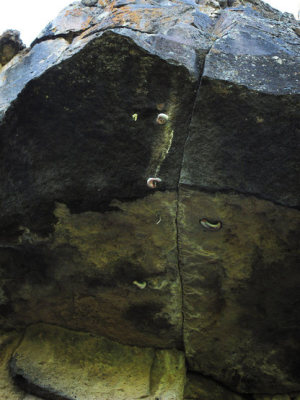
|
| Legit on private land. Photo taken from mountainproject of Crawdad Canyon, UT. |
This article will concentrate on existing established areas that are either on private land that charges fees for use, or are owned and operated by nonprofit conservation or recreation organizations. However, a huge amount of privately-owned climbing areas do not fall into either of these categories. It is not prudent to name them specifically (because of sensitive access issues and overcrowding) but there are quite a few areas in which land owners are fine with letting small amounts of climbers in to climb, provided that they stay low-key and responsible. These climbing areas can be sensitive, and often they are only one piece of litter or screamed profanity away from being closed. By far the best way to approach climbing on small parcels of private land is to inquire with local climbing gyms or access organizations to find out exactly how landowner/climber relations are.
If you want to climb on undeveloped cliffs on private land, approaching landowners can be tricky. Many may be fine with allowing climbers on their land, especially since many cliffs tend to be on rural tracts where owners may already allow activities like hunting. However, the reality is also that most of us climbers tend to be upper middle class suburban or urban types, and there is a cultural divide between many of us and rural landowners. If you approach a rural landowner for climbing, do your homework first. Talk to neighbors, other locals, and learn the details of the land’s history and layout. Find out what the landowner’s favorite beer, football team, or food is. Try to find a local climber who has the same accent and can talk about how his uncle went to high school with the landowner. Above all, be respectful, polite, and understanding as you talk to a landowner.
A major concern that many landowners have is liability. Remember, the general public still very much considers climbing to be a reckless, extreme sport. Many will be paranoid of getting sued or being held liable for any accidents. They are not aware of laws that protect landowners from lawsuits like this, especially if they are not charging money to climb. The Access Fund has a lot of literature on their site specifically addressing these concerns. Beyond this, the Access Fund can also raise money to purchase or lease land from private landowners into what are called “conservation easements,” which we will go into shortly.
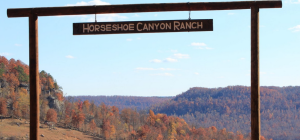
|
Let’s face it, short of owning a mega-gym, it is really hard to make money by charging people to climb. Most privately-owned climbing areas are not as classic or beautiful as public lands, so with a few exceptions they are not national destination areas that would draw in climbers willing to pay the big bucks. Furthermore, once landowners turn climbing into a for-profit business, they are exposed to all sorts of liabilities. This was actually a huge reason that the privately-owned Muir Valley, at the Red River Gorge, has decided to transition into a conservation area and collects donations instead of mandatory fees.
That said, there are a few places in America that have incorporated climbing into their business model. Some, such as Arkansas’s Horseshoe Canyon Ranch, Alabama’s Horse Pens 40, and southern Utah’s Crawdad Canyon were already established as dude ranches, campgrounds, or guest resorts, and simply incorporated climbing into their lineup of activities such as swimming, horseback riding, biker rallies, Civil War reenactments, or mini-golf. In the case of both HCR and Crawdad Canyon, the landowners have taken a very active role in purchasing hardware, hiring route developers, and even providing on-site guide services for their routes. These places are by no means wilderness and might feel over- developed to some climbers, but there is definitely a certain allure to going climbing outside at a place that has just resolved to make itself an easily accessible outdoor gym. And in the case of Horseshoe Canyon and Horsepens, climbing has now become their main cash source. They even hold national-level competitions on their property.
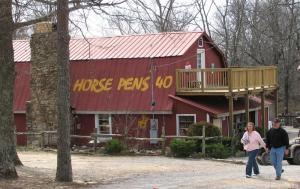
|
| Pictured: Not Climbers |
Other private areas do not make climbing a centerpiece of their business model, but are still friendly to letting climbers pay a few bucks and use their resources, especially if they are already established businesses. The Montlake Country Club of Tennessee doesn’t get too many golfers in the winter months when the friction is the best on its amazing boulders, and so its boulder field– known as Little Rock City or Stone Fort– has become one of the most popular destinations in the Southeast. Less well-known, some friends of mine are at this moment in negotiations with the owner of an RV park in the South, who happens to have a huge boulder field on his property. Realizing that climbers will camp at the park, the landowner is appearing to be receptive to climbing on his land.
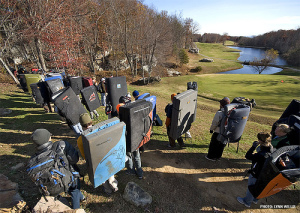
|
| The golf course is not a natural habitat for boulderers, but the species seems to have found its niche here nonetheless. |
There are other areas that do not plan to make huge profits off of their climbing, do not pay for hardware or development, but are still fine charging climbers a small fee to park and climb on their land. As mentioned in the previous installment of this series, Texas has a HUGE amount of private land in relation to its state or federal lands, and inevitably a lot of these big ranches have rock on them. There is even a rumor that there is great limestone on former president George W. Bush’s ranch near Crawford, TX. Sneaking onto Texas ranches in search of rock is a time-honored tradition for some Lone Star climbers, but it is illegal (and if you try that on the Bush ranch, well, let us know how that works out for you).

|
| But, I heard there was really good limestone there! |
That said, some Texas ranches allow climbing. Some of the best limestone in the state, in a beautiful Chihuahuan desert canyon environment, is found at Continental Ranch. Until a few years ago, Reimer’s Ranch in the Hill Country was privately owned and climber-friendly. But other private ranches were open to climbing for a while, but for one reason or another decided to close. Red Bluff, near San Antonio, used to be some of the best bouldering in the state. Paradise on the Brazos, while not the best rock, was the nearest sport climbing to the Dallas/Ft. Worth area. Unfortunately, neither of these areas allow climbing any more, and are unlikely to do so in the future.
Private, Fee-collecting Climbing Areas
- Crawdad Canyon, UT
- Continental Ranch, TX
- Horse Pens 40, AL
- Horseshoe Canyon Ranch, AR
- Skytop, The Gunks, NY (access is only for patrons of the expensive hotel here, who hire a guide)
- Stone Fort, TN
- Torrent Falls, Red River Gorge, KY (access for cabin patrons only)
Perhaps the most longstanding private conservation areas is the Mohonk Preserve in New York, which happens to contain The Gunks, one of the most popular trad areas in the nation. The Preserve is so well-funded and organized that many visitors might just assume that it is a state park of some sort, with its manicured trails, gated parking lots, pay stations, and uniformed rangers. This whole area, with its trails, pools, streams, and cliffs, used to be privately owned by the Mohonk Mountain House, which still operates a lodge and the privately-owned, highly restrictive Skytop crag. However, in 1963, the Mountain House put most of its land into a trust, and later a preserve supported by members and by the state of New York. The result is a huge recreation area that is popular with not just climbers, but bikers, hikers, skiers, birders, and anyone else who needs to get out of NYC.
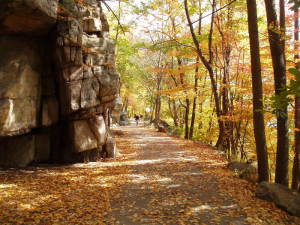
|
Then there are those areas where regional access organizations have managed to raise enough money to simply purchase the cliff lands, essentially creating huge properties that are owned by and operated for climbers. The Red River Gorge was one of the first places in the nation where this happened– in 2004 the Red River Gorge Climber’s Coalition purchased the Pendergrass-Murray Recreational Preserve, and through successful fundraising, managed to pay the property off a couple years ago. They are now actively seeking out, purchasing, and allowing bolting on other crags in the area. In the same vein, Muir Valley, probably the most popular beginner’s area at the RRG, was originally privately owned by the climber-friendly Webers, but is right now in the process of becoming a similar conservation/recreation preserve.
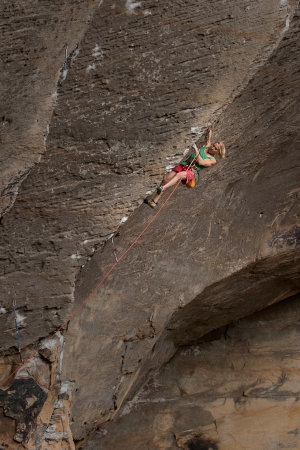
|
| If we own it, they can't take it from us! Still might not help you climb Paradise Lost, though |
Following the RRGCC’s lead, organizations such as the Carolina Climbers Coalition and Southeast Climbers Coalition have also started outright purchasing land, realizing that this is the best way to secure access at areas like Laurel Knob, NC, Hidden Valley, VA, and Yellow Bluff, AL. Needless to say, if you climb at any of the above mentioned areas, regardless of where you are from, donate to these organizations. If we own the land, we will not lose access!
Non-Profit Conservation Easements and Preserves
- Hidden Valley, VA
- Jailhouse Rock, CA
- Laurel Knob, NC
- Mohonk Preserve (Gunks), NY
- Muir Valley, KY
- Pendergrass-Murray and Miller Fork Recreation Preserves, KY
- Yellow Bluff, AL
When I began this three part series, I led off by ranting about how facebook's tagging of climbing photos in the "Red River Gorge National Park" was not just erroneous, but indicative of just how little many climbers know about the intricacies of land ownership, management, and use as it relates to climbing. In the case of the RRG, it is a combination of almost every type of land we've covered here, EXCEPT for National Parks! There is National Forest, Wilderness Area, a state park that bans climbing, a for-profit private area, and two nonprofit climbing preserves. And particularly for climbers such as myself who moved to the East with the assumption that public land was the end-all for climbing access, it turns out that those areas at the Red where climbing is most secure and easiest are those nonprofit climbing preserves!
In the end, there are challenges and benefits to all types of land that we climb on. The key is to know the general missions and objectives of these land types, whether they are state, national, local, or private, and then to research a specific area's rules and regulations for climbing. Happy climbing, and don't forget to donate to climbing organizations!






